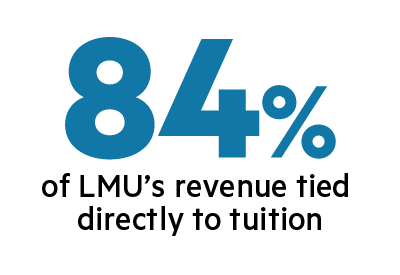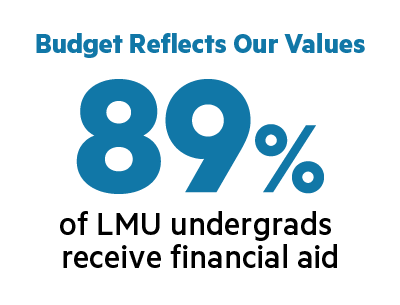Advancing LMU’s Mission in a Changing Environment
The higher education landscape in the United States is undergoing a fundamental transformation - a seismic shift defined by deep and overlapping challenges. Demographic changes and intensifying competition for a diverse and talented student body are reshaping enrollment and access, while external forces - federal policy shifts, reductions in grant funding, inflation, rising healthcare costs, and economic volatility - compound the pressure. These trends are not hypothetical; they are real, measurable, and increasingly urgent. They demand that universities such as LMU innovate thoughtfully, act decisively, and remain grounded in mission while navigating uncertainty.

One of the most urgent challenges is the long-anticipated “demographic cliff” - a sharp decline in the number of traditional college-aged students in the U.S. Beginning around 2026, the number of new high school graduates is projected to drop significantly, with a 13 percent decline expected by 2041 - and a 29 percent decline in California alone. As the college-bound population shrinks, the competition to attract students intensifies. This shift also poses a broader economic threat, as fewer college graduates will mean fewer workers to fill skilled roles, weakening U.S. competitiveness in the global marketplace.
These realities are further complicated by real financial constraints for students and families. Grant aid is diminishing, student loan burdens are growing and families are facing difficult choices.
Relevance, Excellence, and Impact
LMU’s operating budget depends on tuition. Even a relatively small drop in enrollment would exert financial pressure. A more significant enrollment drop in any given year would produce an immediate financial challenge. LMU has carefully analyzed these risks and is taking deliberate steps to ensure today’s decisions secure the university’s long-term relevance, excellence, and impact. As student preferences evolve and the college-going population declines - particularly in California and the West - LMU must broaden how we engage and support prospective students.

Our ability to meet future enrollment goals, while remaining true to our values, depends on increased investment in targeted outreach. This includes building new recruitment pipelines, expanding financial aid strategies, and delivering a student experience that is academically rigorous, inclusive, and responsive to today’s learners. These efforts help limit tuition increases, expand affordability, and preserve the university’s strength for generations to come.
Grounding Our Path Forward
LMU’s proactive choices reflect the same disciplined financial stewardship that has long defined the university’s approach to managing resources. We operate within approved budgets, preserve essential cash reserves, and make strategic investments that position the university for long-term success. As a nonprofit institution, LMU reinvests the majority of tuition and fee revenue directly into its people—through student financial aid, faculty and staff compensation, and holistic student support. Eighty nine percent of LMU undergraduates currently receive some form of financial aid, and our fundraising efforts continue to prioritize scholarships to ensure that every student with talent and drive has the opportunity to attend—and thrive—at LMU.
Every decision we make is guided by our mission, which prioritizes student support, academic quality, and access. It means acting with fiscal prudence, evolving to meet a rapidly changing world, and ensuring LMU continues to thrive as a place of academic excellence, inclusive opportunity, and transformative impact.
Our efforts position LMU to not only withstand the coming challenges - but to lead through them with clarity, confidence, and care.
Download the complete infographic